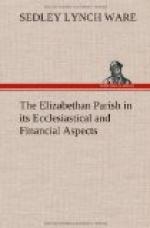When it came to the more accurate basing of rates upon lands, or goods at a valuation, the inhabitants of the various communities observed no uniform ratio of taxation from parish to parish, nor even in the same parish, and disputes were always recurring.[319]
It must be borne in mind that parish financiering was largely of the hand-to-mouth variety. Indeed, it was difficult it should be otherwise, for the exigencies of the civil or the ecclesiastical authorities were constantly shifting, now a petty lump sum being required (and to be spent as soon as raised), now a great one to be disbursed in the same manner.
In conclusion, a few observations on the parish as a financial unit in connection with county government may be made. There seems to have been no general treasury at the disposal of the hundred or of the county, but merely certain treasurers charged with the disbursement of this or that special collection for this or that special purpose. A collection is made by order of the justices, for instance, in certain hundreds, or throughout the shire, for the support of the prisoners in the county gaol, and a treasurer for the fund is appointed. Or it may be that this treasurer is a more or less permanent official. And so with collections for hospitals, for houses of correction, for great bridges, etc. If the constables levied more than was sufficient for a parish, or if the contemplated disbursement turned out to be less than originally estimated, the surplus, if the justices had no immediate use for it, might be returned to that parish to go back into the pockets of the rate payers.[320] Furthermore, it seems scarcely accurate in Elizabethan times to speak of any county rate,[321] for there was no recognized basis of assessment common to all parishes, unless it were at any given time the then prevailing subsidy rate, and a rating according to the subsidy books by the justices would fail to reach many whom a parish rating might attain. As a matter of fact the justices, when they had a large sum to levy on the county at large, almost always apportioned it in lump sums among the hundreds, or among the parishes of their respective divisions, according to “the bygnes or smallnes of their parishes."[322] It comes, then, to all practical intents and purposes to this: that each parish is left to produce according to its own local methods, or rating, the wherewithal for carrying on county government.
While in local government itself the parishioners have practically no voice, the large measure of freedom they enjoy for the devising of ways and means to meet the demands made upon them (though they have no option whatever in granting or withholding supplies) gives to the parish a vigorous entity and a certain autonomous life of its own, which otherwise it never could have possessed over against the all-regulating and inquisitorial Tudor machinery of Church and State.
As the reign advanced the parish developed a selfish, jealous and exclusive gild life of its own, especially under the operation of the poor laws.




